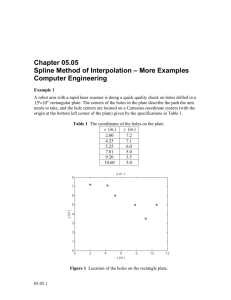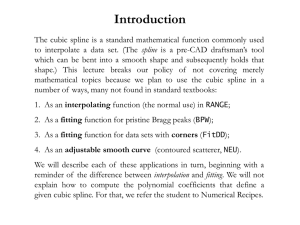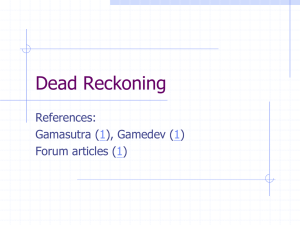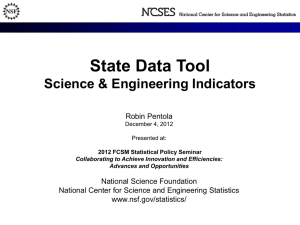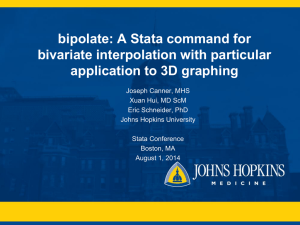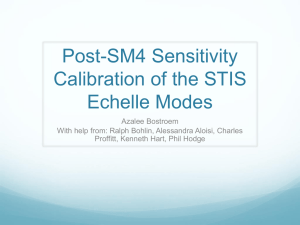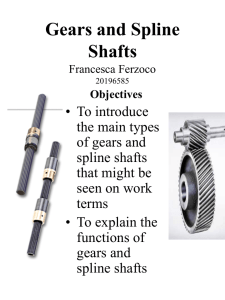Document
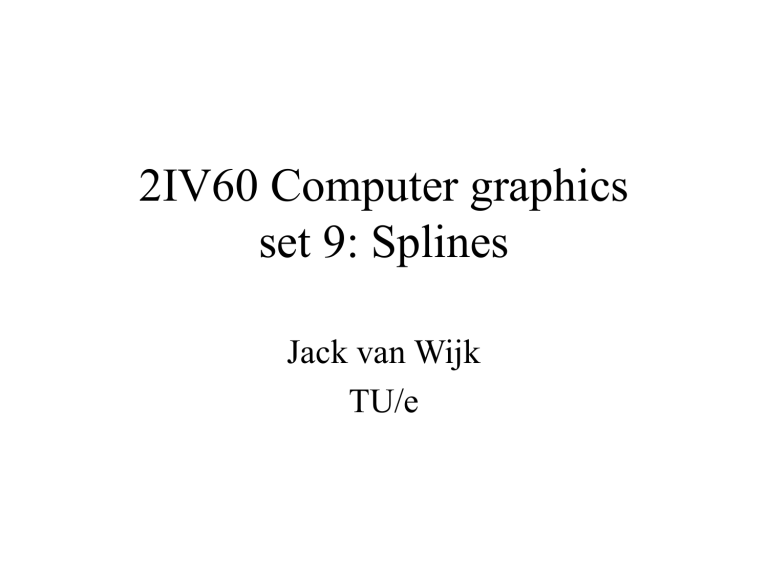
2IV60 Computer graphics set 9: Splines
Jack van Wijk
TU/e
Splines...
Classic problem: How to draw smooth curves?
Spline curve : smooth curve that is defined by a sequence of points
Requirements:
• …
H&B 8-8:420-425
Splines 1
Spline curve : smooth curve that is defined by a sequence of points
Interpolating spline Approximating spline
H&B 8-8:420-425
Splines 2
Convex hull : Smallest polygon that encloses all points
Convex hull
Interpolating spline Approximating spline
H&B 8-8:420-425
Splines 3
Control graph : polyline through sequence of points
Control graph
Interpolating spline Approximating spline
H&B 8-8:420-425
Splines 4
Splines in computer graphics:
Piecewise cubic splines
Segments
H&B 8-8:420-425
Splines 5
Segments have to match ‘nicely’.
Given two segments P ( u ) en Q ( v ).
We consider the transition of P (1) to Q (0).
Zero-order parametric continuity
C 0 : P (1) = Q (0).
Endpoint of P ( u ) coincides with startpoint Q ( v ).
P ( u ) Q ( v )
H&B 8-8:420-425
Splines 6
Segments have to match ‘nicely’.
Given two segments P ( u ) en Q ( v ).
We consider the transition of P (1) to Q (0).
First order parametric continuity
C 1 : d P (1)/d u = d Q (0)/d v .
Direction of P (1) coincides with direction of Q (0).
P ( u ) Q ( v )
H&B 8-8:420-425
Splines 7
First order parametric continuity gives a smooth curve. Sometimes good enough, sometimes not.
line segment circle arc
Suppose that you are bicycling over the curve.
What to do with the steering rod at the transition?
Turn around! Discontinuity in the curvature!
H&B 8-8:420-425
Splines 8
Given two segments P ( u ) and Q ( v ).
We consider the transition of P (1) to Q (0).
Second order parametric continuity
C 2 : d 2 P (1)/d u 2 = d 2 Q (0)/d v 2 .
Curvatures in P (1) and Q (0) are equal.
P ( u ) Q ( v )
H&B 8-8:420-425
Splines 9
So far: considered parametric continuity.
Here the vectors are exactly equal.
It suffices to require that the directions are the same: geometric continuity.
P ( u ) Q ( v ) P ( u ) Q ( v )
H&B 8-8:420-425
Splines 10
Given two segments P ( u ) en Q ( v ).
We consider the transition of P (1) to Q (0).
First order geometric continuity:
G 1 : d P (1)/d u =
d Q (0)/d v with
>0.
Direction of P (1) coincides with direction Q (0).
P ( u ) Q ( v )
H&B 8-8:420-425
Representation cubic spline 1
U : Powers of u C : Coefficient matrix
H&B 8-8:420-425
Representation cubic spline 2
Control points or
Control vectors
H&B 8-8:420-425
Matrix M spline
:’translates’ geometric info to coefficients
Representation cubic spline 3
H&B 8-8:420-425
Representation cubic spline 4
H&B 8-8:420-425
Representatie cubic spline 5
Puzzle: Describe a line segment between the points P
0 with those three variants.
en P
1
P
1 u= 1
P
0 u= 0 u
H&B 8-8:420-425
Representation cubic spline 6
P
1
P
0 u= 0 u
H&B 8-8:420-425
Representation cubic spline 7
P
1
P
0 u= 0 u
H&B 8-8:420-425
Representation cubic spline 8
P
1
P
0 u= 0 u
H&B 8-8:420-425
P
30
P
20
P
10
P
00
Spline surface 1
P
33
P
03
H&B 8-8:420-425
Spline surface 2
H&B 8-8:420-425
P
30
P
20
P
10
P
00
Spline surface 2
P
33
P
03
H&B 8-8:420-425
Spline surface 3 u v
H&B 8-8:420-425
Spline surface 4 v du := 1/nu; // nu: #facets u-direction u dv := 1/nv; // nv: #facets v-direction for i := 0 to nu
1 do u := i*du; for j := 0 to nv
1 do v := j*dv;
DrawQuad(P(u,v), P(u+du, v), P(u+du, v+dv), P(u, v+dv))
H&B 8-8:420-425
Spline surface 5
// Alternative: calculate points first for i := 0 to nu do for j := 0 to nv do
Q[i, j] := P(i/nu, j/nv); u for i := 0 to nu
1 do for j := 0 to nv
1 do
DrawQuad(Q[i, j], Q[i+1, j], Q[i+1, j+1], Q[i, j+1]) v
H&B 8-8:420-425
Spline surface 6
// Alternative: calculate points first,
// triangle version for i := 0 to nu do for j := 0 to nv do
Q[i, j] := P(i/nu, j/nv); u v for i := 0 to nu
1 do for j := 0 to nv
1 do
DrawTriangle(Q[i, j], Q[i+1, j], Q[i+1, j+1]);
DrawTriangle(Q[i, j], Q[i+1, j+1], Q[i, j+1]);
H&B 8-8:420-425
Spline surface 7
// Alternative: calculate points first,
// triangle variant, triangle strip for i := 0 to nu do for j := 0 to nv do
Q[i, j] := P(i/nu, j/nv); for i := 0 to nu
1 do glBegin(GL_TRIANGLE_STRIP); for j := 0 to nv
1 do glVertex(Q[i, j]); glVertex(Q[i, j+1]); glEnd; u v
H&B 8-8:420-425
Bézier spline curves 1
H&B 8-10:432-441
Bézier spline curves 2
P
1
P
0
H&B 8-10:432-441
Bézier spline curves 3
P
1
P
2
P
0
H&B 8-10:432-441
Bézier spline curves 4
P
1
P
2 P
3
P
0
H&B 8-10:432-441
Bézier spline curves 5
P
1
P
2 P
3
P
0
H&B 8-10:432-441
Bézier spline curves 6
P
1
P
2 P
3
P
0
H&B 8-10:432-441
Bézier spline curves 7
P
1
P
2 P
3
P
0
H&B 8-10:432-441
Bézier spline curves 8
P
0
P
1
P
2 P
3
Q
1
Q
0
Q
2
Q
3
H&B 8-10:432-441
Bézier spline curves 8
P
0
P
1
P
2 P
3
Q
0
Q
1
Q
2
Q
3
H&B 8-10:432-441
Bézier spline curves 9
P
0
P
1
P
2 P
3
Q
0
Q
1
Q
2
Q
3
H&B 8-10:432-441
Bézier spline curves 9
P
0
P
1
P
2 P
3
Q
0
Q
1
Q
2
Q
3
H&B 8-10:432-441
Bézier spline curves 10
H&B 8-10:432-441
Bézier surface 1
P
33
P
30
P
20
P
10
P
00
P
03
H&B 8-10:432-441
Q
30
Bézier surface 2
P
33
Q
33
P
30
P
03
Q
03
P
00
H&B 8-10:432-441
Q
00
Q
30
Bézier surface 2
P
33
Q
33
P
30
P
03
Q
03
P
00
H&B 8-10:432-441
Q
00
Q
30
Bézier surface 3
P
33
Q
00
P
30
P
03
P
00
H&B 8-10:432-441
Q
30
Bézier surface 3
P
33
Q
00
P
30
P
03
P
00
H&B 8-10:432-441
Q
30
Bézier surface 3
P
33
Q
00
P
30
P
03
P
00
H&B 8-10:432-441
Finally…
The world is full of all kind of objects:
Trees, people, cars, housed, clouds, rocks, waves, pencil sharpeners, fire, mountains, plants, …
How can we describe these, such that they are
- easy to enter;
- easy to process;
- easy to display?
Complex problem, HUGE topic!
Finally…
Many other ways to model shapes:
–
Sweep representations
– Fractal-Geometry methods
– Shape Grammars
– Procedurally defined objects
– Constructive Solid Geometry
– Subdivision surfaces
– Custom methods for hair, water, fire, etc.
Next…
• We now know how to model curved objects
• But they still look somewhat dull, …
